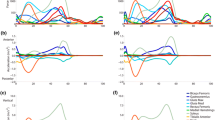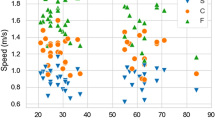Abstract
Purpose
Old compared with young adults walk with reduced ankle and increased hip mechanical output. We examined the idea that age, leg strength, or both are related to the age-related changes in mechanical output during gait.
Methods
Healthy young (n = 32, age 21.5 years) and old adults (n = 32, age 76.8 years) participated in biomechanical gait analyses at 1.5 m/s and were also measured for maximal leg strength.
Results
Analysis 1 confirmed previous data as old compared with young adults walked with 50 % more hip positive work and 18 % less ankle positive work. Analysis 2 showed that leg strength did not affect gait kinetics in groups of subjects with similar ages. In a weak young and a strong old group, Analysis 3 showed that old adults still walked with 23 % greater hip positive work. The group by joint interaction in Analysis 4 was suggestive of an even greater reliance on hip and less reliance on ankle work in weak compared with strong old adults.
Conclusions
Age and leg strength both contribute to the age-related changes in mechanical output during gait. Exercise prescription, normally targeting the knee extensors, should also involve ankle and hip muscles.

Similar content being viewed by others
Abbreviations
- ANOVA:
-
Analysis of variance
- BMI:
-
Body mass index
- SD:
-
Standard deviation
References
Aagaard P, Suetta C, Caserotti P, Magnusson SP, Kjaer M (2011) Role of the nervous system in sarcopenia and muscle atrophy with aging: strength training as a countermeasure. Scand J Med Sci Sports 20:49–64
Abellan van Kan G, Rolland Y, Andrieu S, Bauer J, Beauchet O, Bonnefoy M, Cesari M, Donini LM, Gillette Guyonnet S, Inzitari M, Nourhashemi F, Onder G, Ritz P, Salva A, Visser M, Vellas B (2009) Gait speed at usual pace as a predictor of adverse outcomes in community-dwelling older people an International Academy on Nutrition and Aging (IANA) Task Force. J Nutr Health Aging 13:881–889
Anderson DE, Madigan ML (2014) Healthy older adults have insufficient hip range of motion and plantar flexor strength to walk like healthy young adults. J Biomech 47:1104–1109
Bean JF, Kiely DK, LaRose S, O’Neill E, Goldstein R, Frontera WR (2009) Increased velocity exercise specific to task training versus the National Institute on Aging’s strength training program: changes in limb power and mobility. J Gerontol A Biol Sci Med Sci 64:983–991
Beijersbergen CM, Granacher U, Vandervoort AA, DeVita P, Hortobágyi T (2013) The biomechanical mechanism of how strength and power training improves walking speed in old adults remains unknown. Ageing Res Rev 12:618–627
Boyer KA, Andriacchi TP, Beaupre GS (2012) The role of physical activity in changes in walking mechanics with age. Gait Posture 36:149–153
Callahan D, Phillips E, Carabello R, Frontera WR, Fielding RA (2007) Assessment of lower extremity muscle power in functionally-limited elders. Aging Clin Exp Res 19:194–199
Carrier DR, Anders C, Schilling N (2011) The musculoskeletal system of humans is not tuned to maximize the economy of locomotion. Proc Natl Acad Sci 108:18631–18636
Claflin DR, Larkin LM, Cederna PS, Horowitz JF, Alexander NB, Cole NM, Galecki AT, Chen S, Nyquist LV, Carlson BM, Faulkner JA, Ashton-Miller JA (2011) Effects of high- and low-velocity resistance training on the contractile properties of skeletal muscle fibers from young and older humans. J Appl Physiol (1985) 111:1021–1030
Clark DJ, Reid KF, Patten C, Phillips EM, Ring SA, Wu SS, Fielding RA (2014) Does quadriceps neuromuscular activation capability explain walking speed in older men and women? Exp Gerontol 55:49–53
Clark BC, Taylor JL, Hong SL, Law TD, Russ DW (2015) Weaker seniors exhibit motor cortex hypoexcitability and impairments in voluntary activation. J Gerontol A Biol Sci Med Sci 70(9):1112–1119
Dalton BH, Power GA, Vandervoort AA, Rice CL (2010) Power loss is greater in old men than young men during fast plantar flexion contractions. J Appl Physiol 109:1441–1447
Dalton BH, Allen MD, Power GA, Vandervoort AA, Rice CL (2014) The effect of knee joint angle on plantar flexor power in young and old men. Exp Gerontol 52:70–76
Danneskiold-Samsoe B, Bartels EM, Bulow PM, Lund H, Stockmarr A, Holm CC, Watjen I, Appleyard M, Bliddal H (2009) Isokinetic and isometric muscle strength in a healthy population with special reference to age and gender. Acta Physiol (Oxf) 197(Suppl 673):1–68
Dempster WT (1955) Space requirements of the seated operator. Wright-Patterson Air Force Base, Ohio, pp 183–197
DeVita P, Hortobágyi T (2000) Age causes a redistribution of joint torques and powers during gait. J Appl Physiol 88:1804–1811
Dingwell JB, Cusumano JP (2000) Nonlinear time series analysis of normal and pathological human walking. Chaos 10:848–863
Farris DJ, Sawicki GS (2012) The mechanics and energetics of human walking and running: a joint level perspective. J R Soc Interface 9:110–118
Fielding RA, Rejeski WJ, Blair S, Church T, Espeland MA, Gill TM, Guralnik JM, Hsu FC, Katula J, King AC, Kritchevsky SB, McDermott MM, Miller ME, Nayfield S, Newman AB, Williamson JD, Bonds D, Romashkan S, Hadley E, Pahor M (2011) The Lifestyle Interventions and Independence for Elders Study: design and methods. J Gerontol A Biol Sci Med Sci 66:1226–1237
Franz JR, Kram R (2012) The effects of grade and speed on leg muscle activations during walking. Gait Posture 35:143–147
Franz JR, Kram R (2013) How does age affect leg muscle activity/coactivity during uphill and downhill walking? Gait Posture 37:378–384
Goldberg EJ, Neptune RR (2007) Compensatory strategies during normal walking in response to muscle weakness and increased hip joint stiffness. Gait Posture 25:360–367
Graf A, Judge JO, Ounpuu S, Thelen DG (2005) The effect of walking speed on lower-extremity joint powers among elderly adults who exhibit low physical performance. Arch Phys Med Rehabil 86:2177–2183
Harbo T, Brincks J, Andersen H (2012) Maximal isokinetic and isometric muscle strength of major muscle groups related to age, body mass, height, and sex in 178 healthy subjects. Eur J Appl Physiol 112:267–275
Hartmann A, Murer K, de Bie RA, de Bruin ED (2009) The effect of a foot gymnastic exercise programme on gait performance in older adults: a randomised controlled trial. Disabil Rehabil 31:2101–2110
Hortobágyi T, Zheng D, Weidner M, Lambert NJ, Westbrook S, Houmard JA (1995) The influence of aging on muscle strength and muscle fiber characteristics with special reference to eccentric strength. J Gerontol A Biol Sci Med Sci 50:B399–B406
Hortobágyi T, Mizelle C, Beam S, DeVita P (2003) Old adults perform activities of daily living near their maximal capabilities. J Gerontol A Biol Sci Med Sci 58:M453–M460
Judge JO, Davis RB 3rd, Ounpuu S (1996) Step length reductions in advanced age: the role of ankle and hip kinetics. J Gerontol A Biol Sci Med Sci 51:M303–M312
Kerrigan DC, Todd MK, Della Croce U, Lipsitz LA, Collins JJ (1998) Biomechanical gait alterations independent of speed in the healthy elderly: evidence for specific limiting impairments. Arch Phys Med Rehabil 79:317–322
Kerrigan DC, Lee LW, Collins JJ, Riley PO, Lipsitz LA (2001) Reduced hip extension during walking: healthy elderly and fallers versus young adults. Arch Phys Med Rehabil 82:26–30
Kulmala JP, Korhonen MT, Kuitunen S, Suominen H, Heinonen A, Mikkola A, Avela J (2014) Which muscles compromise human locomotor performance with age? J R Soc Interface 11:1754–1768
Lim YP, Lin YC, Pandy MG (2013) Muscle function during gait is invariant to age when walking speed is controlled. Gait Posture 38:253–259
Lindle RS, Metter EJ, Lynch NA, Fleg JL, Fozard JL, Tobin J, Roy TA, Hurley BF (1997) Age and gender comparisons of muscle strength in 654 women and men aged 20–93 yr. J Appl Physiol 83:1581–1587
McGibbon CA (2003) Toward a better understanding of gait changes with age and disablement: neuromuscular adaptation. Exerc Sport Sci Rev 31:102–108
McGibbon CA, Krebs DE (2004) Discriminating age and disability effects in locomotion: neuromuscular adaptations in musculoskeletal pathology. J Appl Physiol 96:149–160
Menz HB, Morris ME, Lord SR (2005) Foot and ankle characteristics associated with impaired balance and functional ability in older people. J Gerontol A Biol Sci Med Sci 60:1546–1552
Metter EJ, Lynch N, Conwit R, Lindle R, Tobin J, Hurley B (1999) Muscle quality and age: cross-sectional and longitudinal comparisons. J Gerontol A Biol Sci Med Sci 54:B207–B218
Miyazaki J, Murata S, Horie J, Uematsu A, Hortobágyi T, Suzuki S (2013) Lumbar lordosis angle (LLA) and leg strength predict walking ability in elderly males. Arch Gerontol Geriatr 56:141–147
Monaco V, Rinaldi LA, Macri G, Micera S (2009) During walking elders increase efforts at proximal joints and keep low kinetics at the ankle. Clin Biomech (Bristol, Avon) 24:493–498
Narici MV, Maffulli N (2011) Sarcopenia: characteristics, mechanisms and functional significance. Br Med Bull 95:139–159
Power GA, Makrakos DP, Stevens DE, Herzog W, Rice CL, Vandervoort AA (2014) Shortening-induced torque depression in old men: Implications for age-related power loss. Exp Gerontol 57:75–80
Reid KF, Fielding RA (2012) Skeletal muscle power: a critical determinant of physical functioning in older adults. Exerc Sport Sci Rev 40:4–12
Savelberg HH, Verdijk LB, Willems PJ, Meijer K (2007) The robustness of age-related gait adaptations: can running counterbalance the consequences of ageing? Gait Posture 25:259–266
Silder A, Heiderscheit B, Thelen DG (2008) Active and passive contributions to joint kinetics during walking in older adults. J Biomech 41:1520–1527
Stenroth L, Sillanpaa E, McPhee JS, Narici MV, Gapeyeva H, Paasuke M, Barnouin Y, Hogrel JY, Butler-Browne G, Bijlsma A, Meskers CG, Maier AB, Finni T, Sipila S (2015) Plantarflexor muscle-tendon properties are associated with mobility in healthy older adults. J Gerontol A Biol Sci Med Sci 70(8):996–1002
Uematsu A, Tsuchiya K, Kadono N, Kobayashi H, Kaetsu T, Hortobágyi T, Suzuki S (2014) A behavioral mechanism of how increases in leg strength improve old adults’ gait speed. PLoS One 9:e110350
Umberger BR, Martin PE (2007) Mechanical power and efficiency of level walking with different stride rates. J Exp Biol 210:3255–3265
Winter DA, Patla AE, Frank JS, Walt SE (1990) Biomechanical walking pattern changes in the fit and healthy elderly. Phys Ther 70:340–347
Yamauchi J, Mishima C, Nakayama S, Ishii N (2010) Aging-related differences in maximum force, unloaded velocity and power of human leg multi-joint movement. Gerontology 56:167–174
Acknowledgments
We thank Dr. Alessio Murgia for his insightful comments.
Author information
Authors and Affiliations
Corresponding author
Ethics declarations
Funding
Supported in part by National Institutes of Health AG024161.
Additional information
Communicated by Fausto Baldissera.
Rights and permissions
About this article
Cite this article
Hortobágyi, T., Rider, P., Gruber, A.H. et al. Age and muscle strength mediate the age-related biomechanical plasticity of gait. Eur J Appl Physiol 116, 805–814 (2016). https://doi.org/10.1007/s00421-015-3312-8
Received:
Accepted:
Published:
Issue Date:
DOI: https://doi.org/10.1007/s00421-015-3312-8




